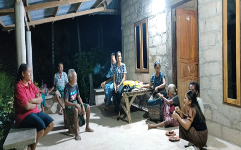Fieldwork on Traditional Ethnobotanical Knowledge in Sabu and Raijua Indonesia September 2023–March 2024
- monikakarmin
- Jul 18, 2024
- 2 min read
Mellissa E.S. Ledo lead the team that included James Ngginak, Apriliana Ballo, Mibels N. Heke, Yhersi Ndun, Berto D. Hano, Alfandi Ngede, and Joni A. Ame, all from Universitas Artha Wacana (UKAW). The project is consulted by OCSEAN facilitators George Saad and late June Jacob.
Ethnobotany field research was done in September 2023–March 2024 in 10 villages on Sabu Island and 2 villages on Raijua Island.

Map showing the location of Sabu and Raijua Islands within Indonesia
The journey was challenging, but exciting to reach the community that has unique local knowledge related to the ethnobotany of medical, edible, and natural dye plants, but less information and documentation about do hawu (people from Saburaijua Island) and their cultures. Informants were the elders (55 people) from the villages who practiced traditional medicine, the patients, the weavers who still used plants as natural dyes, and traditional food makers.
UKAW team project and informan person in Sabu Raijua
Data on 116 species of plants and their usage was collected.
In addition samples from Schleichera oleosa, Indigofera sp., and Ochrosia sp. (white and red flowers) were chosen for DNA barcoding in the Biotechnology Laboratory at Gadjah Mada University, Yogyakarta. Initial NCBI Blast analyses shows a 99.56% similarity between Schleichera oleosa from Sabu and Schleichera oleosa isolate SBB-0013F; Indigofera sp. from Sabu has a 97.38% similarity with Indigofera esquirolii voucher CFL2896; and Ochrosia sp. (white and red flowers) has a 96.99% similarity with Ochrosia borbonica isolate OCBO1.
A plant picture dictionary from Sabu Raijua was made and used for teaching and learning with students at Hawu Mehara and East Sabu Senior High School to promote Traditional Knowledge among the young generation. Discussions with science teachers in the school and biotechnology lab practicals in school based on local knowledge was a precious experience. This was to encourage teachers to provide simple laboratory practicals for the students and show the value of local plants and traditional knowledge.
Teaching and learning using a plant picture dictionary from Sabu Raijua and discussion with a science teacher about biotechnology based on local knowledge practice in the laboratory


This project has received funding from the European Union’s Horizon 2020 research and innovation programme under the Marie Skłodowska-Curie grant agreement No 873207.











Comments